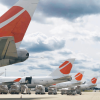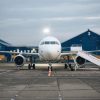 The recent Farnborough 2016 airshow has brought over $120 billion-worth of orders. In their pursuit to operate the latest aircraft models, Asian customers, to no one’s surprise, are leading the order books. But the upcoming delivery of hundreds of new aircraft will inevitably force market players to find new owners and lessors for the aging fleet. With still rather moderate experience in aircraft leasing market, will Asian leasing companies, particularly in China, be able to successfully remarket their mid-life airplanes?
The recent Farnborough 2016 airshow has brought over $120 billion-worth of orders. In their pursuit to operate the latest aircraft models, Asian customers, to no one’s surprise, are leading the order books. But the upcoming delivery of hundreds of new aircraft will inevitably force market players to find new owners and lessors for the aging fleet. With still rather moderate experience in aircraft leasing market, will Asian leasing companies, particularly in China, be able to successfully remarket their mid-life airplanes?
Over the past 10-15 years, Chinese financial institutions have been actively exploring the aviation market, including aircraft leasing. During the period, they have built a combined fleet of almost 1000 aircraft from scratch. Most of these aircraft – 80-85% – are currently operated by Chinese airlines. However, as the fleet keeps growing older and airlines are increasingly looking towards the next generation aircraft, local leasing companies may find that remarketing their mid-life assets may be harder than expected. After all, many Chinese lessors are only several years in the business and the remarketing process requires both technical expertise and established relations with other market players, first and foremost, outside of China,” comments Tadas Goberis, the CEO of AviaAM Leasing.
Today, the absolute majority – about 90% – of all commercial airplanes used in China are up to 8 years old. In the early 2020s, the share will drop to ~80%, meaning that approx. every fifth aircraft in China will be at least 10-15 years old. It also means that over the following several years, almost a thousand of commercial airplanes in China will pass the mark of 15 years.
“Approx. 40% of aircraft in China are operated under various lease agreements. But whether the aircraft is leased or directly owned by a carrier, the trend is obvious – step by step the local aircraft market keeps approaching its maturity. Amongst other, it means that more and more aircraft owners, including the newly established lessors, will have to face the issue of what to do with their assets in order to get the most value. As hundreds of narrow and wide-body aircraft reach the end of their first lease periods by the end of this decade, the redelivery process will become a major challenge to Chinese lessors who have not dealt with it before,” explains Tadas Goberis.
A well-managed process of aircraft redelivery and its subsequent delivery to the next lessee can take a couple of months; however, the process can also stretch up to a year. The biggest challenge to be faced is making  sure that the health of your asset is well managed. Throughout the period of each lease, a lessor must conduct continuous supervision of the aircraft’s technical condition. If revealed during the redelivery inspection only, poor maintenance, utilization of unauthorized spare parts, improper technical record management, etc. will require unscheduled shop visits, additional inspections and, eventually, will result in delays when it comes to delivering the asset to a future lessee or owner. As a result, it will cost the lessor several millions of dollars in additional expenses and lost revenues.
sure that the health of your asset is well managed. Throughout the period of each lease, a lessor must conduct continuous supervision of the aircraft’s technical condition. If revealed during the redelivery inspection only, poor maintenance, utilization of unauthorized spare parts, improper technical record management, etc. will require unscheduled shop visits, additional inspections and, eventually, will result in delays when it comes to delivering the asset to a future lessee or owner. As a result, it will cost the lessor several millions of dollars in additional expenses and lost revenues.
Therefore, a lessor should start preparing for the process 12-18 months in advance. Otherwise, any unexpected findings during the redelivery, or worse, during the delivery to a next operator or buyer, may substantially impact lease conditions or reduce the asset’s price by 15-30%. Naturally, the lessor’s inability to deliver the aircraft under the agreed terms and on time may bring dire consequences. A customer may simply walk away and leave you with an asset which keeps generating anything but profit.
But even should the redelivery process go smoothly, remarketing a 10-15 years old aircraft might still pose a challenge, especially considering the fact that many Chinese airlines prefer newly-built aircraft. Therefore, in search for the best buyer or lessee, Chinese lessors will be forced to open themselves to the global market.
Since 2/3 of airplanes owned by Chinese lessors are operated inside the country, many local leasing companies have a rather vague understanding of the airline market trends outside of China, left alone any long-standing relations with airlines in Europe or North America which are much more open to mid-life aircraft.
Add the substantial differences in aviation and financial regulations in various world regions and most Chinese lessors with just several years of active presence in the aircraft leasing market will find themselves in big trouble. This applies to both second lease scenarios and end-of-life projects like aircraft tear downs. The latter can provide 15-20% of the asset’s initial value, subject to the owner’s expertise of the MRO market.
“All in all, after enjoying many years of stable returns, Chinese investors should start preparing for the next stage in managing their aviation assets and ensuring the highest residual values. With proper guidance, experience and timely actions, most of the redelivery and remarketing pitfalls can be avoided,” concludes Tadas Goberis, the CEO of AviaAM Leasing.





